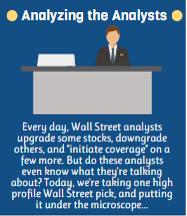
Analysts say the strangest things. Two weeks ago we took a look at Vertical Research Partners’ suggestion that if it were true that PotashCorp (NYSE: POT) was about to buy Agrium (NYSE: AGU) , then the logical thing to do in response was sell these two companies’ primary rival, The Mosaic Company (NYSE: MOS) .
Today, we know that Potash will in fact try to merge with Agrium to form one of the largest fertilizer companies in the world. And this time around, we’re hearing that another analyst entirely thinks that the right response to this news is not to sell Mosaic necessarily — but definitely to buy Potash.
Here are three things you need to know about that.

Stifel Nicolaus sees gold in PotashCorp. Image source: Getty Images.
1. Stifel Nicolaus loves this merger
As related on StreetInsider.com this morning, the analyst in question is Stifel Nicolaus, and it’s one of our top-ranked investors on Motley Fool CAPS . This morning, Stifel announced that it is upgrading PotashCorp stock from hold to buy on the merger news, and raising its price target to $ 20. Because PotashCorp stock currently costs just a hair more than $ 16 per share, that works out to a potential profit of 25% for new investors — if the analyst is right.
2. Is Stifel Nicolaus right?
It depends. As you’re probably well aware right now, fertilizer prices are in the dumps . In fact, things have gotten so bad that a few months back, the venerable financial newspaper Financial Times devoted an entire column to discussing how the market prices of phosphate, potash, and nitrogen fertilizers had plunged by “more than a fifth.” As the Times described back in April, fertilizer costs per acre of farm production had fallen below the costs of seeding those fields — for the first time in the 14 years that Purdue University had been keeping track of the dynamic.
That’s obviously not good news for companies like PotashCorp, which make most of their money mining and selling this fertilizer wholesale. It’s not as bad news for companies like Agrium, which do a lot of business retailing fertilizer, however. Those low fertilizer prices attract customers after all, and that’s good for Agrium’s business. Last quarter for example, Agrium highlighted “solid demand for crop inputs, lower costs and strong margins within our ag-retail distribution business” at the top of its earnings report.
Thus, explains TheFly.com , one reason Stifel likes PotashCorp’s tie-up with Agrium, is that it will give Potash “shelter from a difficult nutrient price environment and access to growth in the form of Agrium’s retail exposure.”
3. Cautious optimism
Stifel sees three things that could potentially go wrong with this merger. First, it could fail to happen at all, if shareholders vote it down. (That’s not a huge risk in Stifel’s opinion, as the analyst sees the deal being nearly as good for Agrium as it is for PotashCorp.)
Second, Stifel notes that the merger’s attractions could be diluted if regulators approve the merger but demand the PotashCorp and Agrium divest certain assets to minimize monopoly concerns. (Again, not a huge worry. Even if divestitures are ordered, that would imply that regulators will still approve the deal.)
Third, though, Stifel notes that PotashCorp and Agrium management are promising $ 500 million worth of synergies from their merger. We all know how these kinds of ” synergies ” promises tend to work out after these kinds of deals, and Stifel does, too. Accordingly, it’s taking those promises with a grain of salt, and “risk adjusting” that $ 500 million down by 33%, assuming the companies will save only two-thirds as much money by merging as they say they will.
The most important thing: Valuation
Despite all these caveats to its endorsement, Stifel Nicolaus is still of the opinion that a PotashCorp with Agrium is worth 25% more than a PotashCorp without Agrium — and stands by its $ 20 price target. So does that assertion make sense?
Well let’s consider: Over the past year, PotashCorp earned $ 868 million in profits. Let’s assume that Stifel Nicolaus is right about the 33% “risk adjustment” to PotashCorp’s promised $ 500 million in “synergies.” And let’s further split the remaining $ 335 million worth of synergies roughly in half, and assign $ 174 million of them to PotashCorp — because this is being described as a “merger of equals” combination, in which PotashCorp shareholders will own 52% of the combined companies’ stock.
Taking all this at face value, it’s reasonable to assume that PotashCorp might earn $ 1.04 billion in profit as part of a combined PotashCorp-Agrium, or 20% more than it is currently earning alone. That seems in line with Stifel’s new $ 20 price target for PotashCorp stock — 25% above where it sits today. Add in the potential for a larger PotashCorp-Agrium entity exerting a bit of supply-side control over potash prices going forward, and by cutting production and raising prices, the potential for the stock to become worth 25% more than it was worth before the merger does make sense.
Mind you: I’m not saying Stifel Nicolaus is right about the valuation just yet. (I’ll actually be taking a closer look at that later this week.) But for the time being, focusing solely on the logic of the upgrade — yes, on its face, I think this one makes sense.
A secret billion-dollar stock opportunity
The world’s biggest tech company forgot to show you something, but a few Wall Street analysts and the Fool didn’t miss a beat: There’s a small company that’s powering their brand-new gadgets and the coming revolution in technology. And we think its stock price has nearly unlimited room to run for early in-the-know investors! To be one of them, just click here .
Fool contributor Rich Smith does not own shares of, nor is he short, any company named above. You can find him on Motley Fool CAPS , publicly pontificating under the handle TMFDitty , where he currently ranks No. 286 out of more than 75,000 rated members.
The Motley Fool has no position in any of the stocks mentioned. Try any of our Foolish newsletter services free for 30 days . We Fools may not all hold the same opinions, but we all believe that considering a diverse range of insights makes us better investors. The Motley Fool has a disclosure policy .
The views and opinions expressed herein are the views and opinions of the author and do not necessarily reflect those of Nasdaq, Inc.
Plantations International